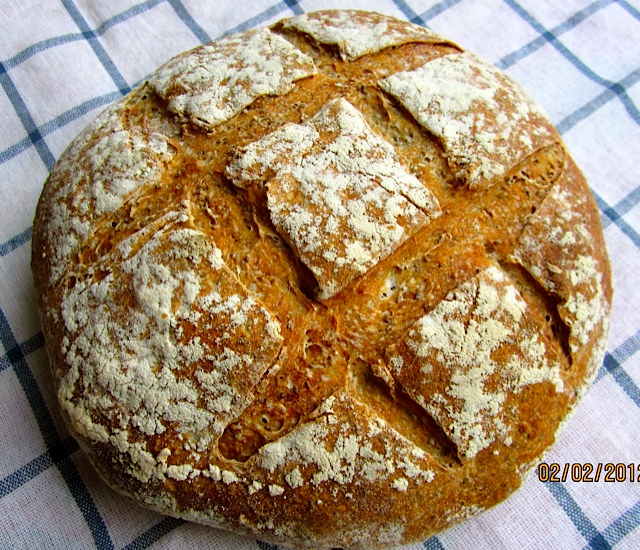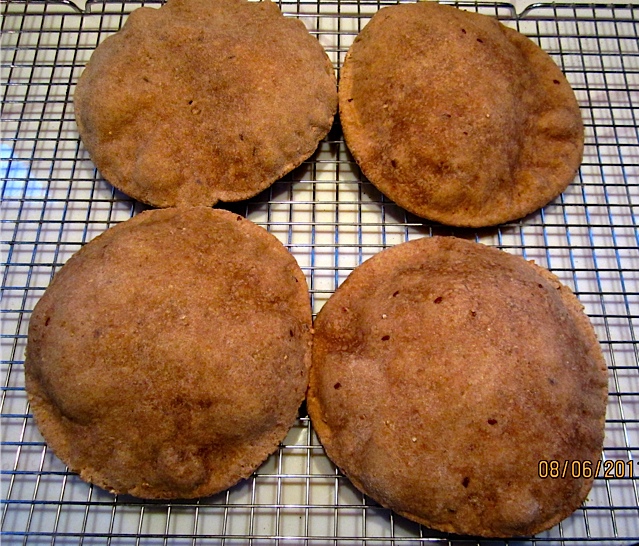
In 2012 I had made a New Year's resolution - to give all my baking books a fair chance.
I wanted to bake one bread from every one of them, not only from my couple of favorite books. "Equal Opportunity Baking" was born!
With Malt Rye Rolls and Saatenbrot I was off for a roaring start. Also, Muesli Rolls and
Beer Rye Bread worked out after some tweaking.
But then some loaves folllowed that either required a lot of trials, or underwhelmed me with their taste. My initial enthusiasm was dampened, and the last posts endet up with the sympathetic hobby bakers of The Fresh Loaf, and didn't make it to my blog.
That is about to change now, I renewed my resolution (please, no knowlegeable grins!) In the meantime my baking book collection didn't diminish - on the contrary! - and the to-do-list of breads is large. So, here we go!
Was it my childish resistance against praying with St. Jeffrey's faithful congregation, or an unconscious dislike of dealing with a tome - so far I haven't baked a lot from Hamelman's "Bread".
Though one bread, the wonderful "5-Grain Sourdough with Rye Sourdough", made it straight into Karin's Bread Hall of Fame, and I used his "Rye Sourdough with Walnuts" formula for testing a 1-step versus a 3-step starter. But that was it!
For my "Equal Opportunity Pledge", I wanted to kill two birds with one stone, having another go at "Bread", and finding a use for the chia seed I had just purchased for a bargain price. Therefore I chose a simple white loaf to jazz up with the omega-3-rich seeds: Country Bread.
Working with the recipe wasn't very difficult. I refrigerated the mature pre-ferment overnight, and upped the amount of water in the dough a bit to accommodate the seeds (I didn't soak them, because - according to the description on the tag - "You can eat them directly out of the package").
The dough was slightly sticky, as intended, and I gave it an extra Stretch & Fold right away, and let it ferment for an additional 50 minutes after the last S&F.
The result was a very pretty loaf, with a pleasant, slightly nutty taste - for
COUNTRY BREAD WITH CHIA SEEDS (adapted from Jeffrey Hamelman's "Bread")
Pre-Ferment
227 g bread flour
136 g water
4 g/3/4 tsp. salt
1 pinch instant yeast
Final Dough
all pre-ferment
227 g bread flour
185 g water
45 g chia seeds
5 g salt
0.9 g/1/4 tsp. instant yeast
DAY 1
Mix pre-ferment ingredients just until smooth. Cover, and leave at room temperature for 12 - 16 hours (70ºF/21ºC.) It will be ready to use, when it has domed, and is just starting to recede in the center. (I refrigerated the mature pre-ferment overnight.)
DAY 2
Cut pre-ferment in 12 small pieces. Mix all final dough ingredients, at low speed, until all flour is hydrated, and dough comes together (about 3 minutes,) adjusting with a little more water, as needed. Dough should be slightly sticky.
Continue kneading at medium speed for 3 minutes more. Dough should be supple, and still a bit sticky (Desired dough temperature 75ºF/24ºC).
Transfer to a lightly oiled or moistened work surface. With oiled or wet hands, stretch and pat it into a rough square. Fold it from top and bottom like a business letter, then do the same from the left and right side. Gather dough package into a ball, tucking sides under, and place into a lightly oiled bowl.
Cover, and let rise for about 2 1/2 hours, with 2 folds at 50 minute intervals. (In my cooler kitchen the rising time was 50 minutes longer.)
Pre-shape dough into a round, and place on the lightly floured work surface, seam side up. Cover, and let relax for 10 - 20 minutes, then shape into a boule or bâtard.
Place, seam side up, into a floured banneton, sprinkle with more flour, cover, and proof for 75 - 90 minutes (at 75ºF/24ºC), or longer, when your kitchen is cooler.
About half an hour before baking, preheat oven to 450ºF/230ºC, with baking stone and steam pan.
Use the finger poke test, the bread is ready for the oven, when a dimple doesn't fill up again, only comes back a little bit. Transfer loaf to a parchment lined baking sheet (or bake directly on baking stone.) Score into desired pattern.
Bake bread for 15 minutes, steaming with a cup of boiling water. Rotate bread 180 degrees, remove steam pan, and continue baking for another 20 minutes, or until loaf is golden brown, sounds hollow when thumped on the bottom and registers at least 200ºF/93ºC.
Let bread cool on wire rack.
 |
| An attractive looking bread: mild, with a slightly nutty flavor |
BreadStorm-Users, (including the free version) can download the formula here.


+(%25).png)













